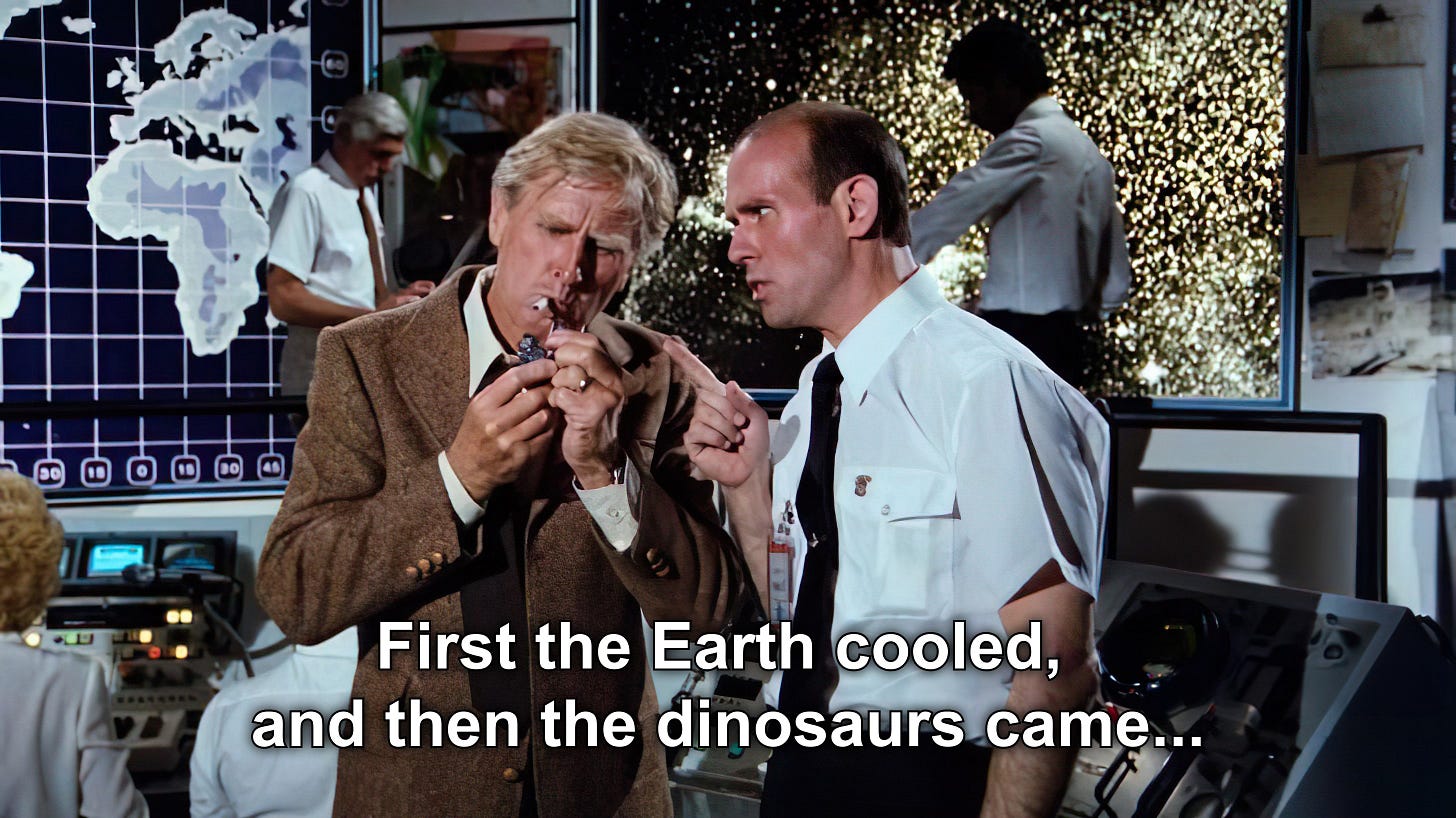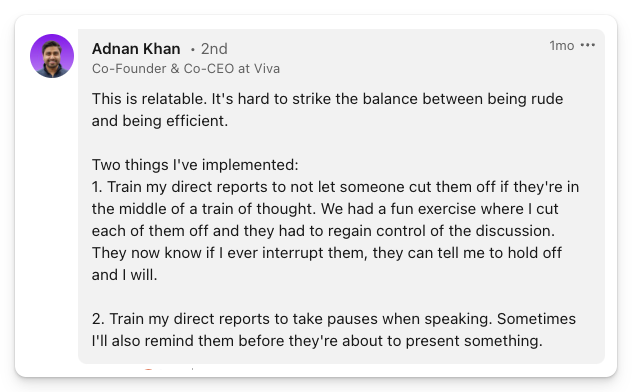How to interrupt (and be interrupted) respectfully in the workplace
Your goal is to get a shared understanding—not to deliver your full monologue. Don’t run out of time for the important stuff.
👋 Hey, it’s Wes. Welcome to my weekly newsletter where I share frameworks for becoming a sharper operator, rooted in my experience as an a16z-backed founder.
Read time: 11 minutes
✨ If you’re interested in sponsoring this newsletter to reach 30,000+ thoughtful operators, fill out this form and I can share more.
Have you ever listened to a coworker speak for 10 minutes, when it could have been 10 seconds, because you knew what they were saying but you felt bad about interrupting?
Interruptions when you’re speaking are usually seen as bad, but there are strategic reasons to encourage folks to interrupt you. Here’s when to allow interruptions, and how to politely interrupt others.
Part I: Two kinds of interruptions
Part II: How to stay in control when you’re interrupted
Part III: How to interrupt politely
Part I: Two kinds of interruptions
Many people are afraid to interrupt because they don’t want to seem rude. But not all interruptions are created equal. There are two kinds of interruptions:
Bad interruptions are when you can’t finish a thought without others cutting you off. Your listener is condescending, rude, and brash. They don’t respect you.
Good interruptions are when reasonable people have reasonable reasons to interrupt, and they do so respectfully. You have mutual respect and trust. They understand your point and want to make the best use of limited time.
Obviously, you want to avoid bad interruptions. But you should encourage good interruptions too. Why? Limited time. When you’re short on time and it’s hard to get on your executive’s calendar, you need to be mindful of backstory scope creep. You can’t waste precious minutes on irrelevant tangents or issues you’re already aligned on.
If people can’t interrupt you, the result is you may need to schedule another meeting (or three) to discuss what you could have done in one sitting. Not great.
It’s natural to want to finish your presentation, especially if you’ve put effort into preparing it. This is when it’s especially important to set your ego aside:
Ego sounds like this: “I must stick with my agenda. I worked hard to put this together. I want to share it all, and if we answer this question (even though it’s a great question), it deviates from what I worked on.”
On the other hand, effectiveness sounds like this: “I might stick with my agenda, or I deviate from it. All my preparation has led up to this moment, so nothing was “wasted” even if I don’t present all of my slides.”
Notice how effectiveness isn’t necessarily a blanket “always deviate” or “always double down on my agenda.” Your response depends on the quality of the insight or question. If you get a great question, it would be foolish to ignore it.
In some of my most productive meetings, I used talking points to kick off and had data ready to share, but went through 20% of what I prepared. But we discussed what was important and useful—that’s the goal. Getting to that is a win.
Part II: How to stay in control when you’re interrupted
Here’s a question from reader Irina Stanescu, former staff software engineer at Uber and Google:
“What would you say in situations where you get interrupted, but you feel like it’s not for a good reason or [they] jumped to conclusions too soon?”
In my first job out of college, I thought presenting to senior leadership was a formal, one-directional presentation. When an exec inevitably asked me a question partway through, I would get flustered and lose my talking points.
I soon realized presenting front to end without any interruptions is actually quite rare. Many internal presentations are more like guided conversations—it was my responsibility to drive the meeting, but there was often dialogue, debate, and conversation.
When you expect potential interruptions or questions, it takes the wind out of it being a surprise, so you’re much more likely to stay in control and take it in stride.
What if you believe the question you’re being asked is legitimately misguided? Here are scripts I’ve found helpful:
1. “I know we’re short on time, and have a lot to cover. Feel free to raise your hand if I’m going too far down a direction you already know, or if you have questions along the way. The goal for today is to X and I’ll start by sharing a bit about Y and Z.”
Always frame your topic upfront—this prevents bad interruptions down the line because your audience knows what to expect and can stay focused. Sharing the agenda serves as sign posting for what’s coming later. (For more on leading meetings, check out how to present to your CEO and act like an owner.)
2. “Good question. That’s why I want to cover X because it actually addresses [the thing they asked about].”
Good question - Saying good question isn’t about being nice. You’re starting on a positive note because you’re about to introduce conflict. The conflict: They asked you a question, and you’re flouting their expectations by NOT answering it. So you need to anchor on the warmer side of the spectrum to counterbalance.
That’s why I want to cover X - This redirects back to what you want to talk about.
Because it actually addresses - Position what you’re saying around their concern. You’re saying, “Actually I WILL address your question, but in a different way that really gets at the root of the issue, so stick with me.”
3. “Good question. Let’s hold on that because what I’m about to share hits on the core of what I believe you’re asking, which is ___.”
Figure out the question behind the question of what they’re asking. When you say what I’m about to share hits on what I think is the core of what you’re asking, you come from a place of curiosity and anticipating their needs. For an advanced strategy, you can interpret their question liberally to be essentially what you think they should have asked—not what they actually asked. Basically, you use this as an opportunity to reframe and redirect back to your main point.
4. “We can definitely talk about that, but we only have 15 minutes left. Are you good if I continue and share the most important things, then we can discuss?”
When you remind people of the cost of their tangent, most people are happy to continue. Most people do not want to schedule yet another meeting and add more work to their plate.
5. “Great question. [Quickly answer in 1 sentence] [Immediately redirect back to what you were saying].”
I do this one a lot and find it super useful. This removes tension from an unanswered question. You address it in one sentence, but don’t allow it to expand beyond that. You redirect immediately to bring it back to where you believe the conversation should go.
This applies to all the scripts, but remember to take pauses when speaking. When you pause, you give people time to chime in without needing to cut you off. If you talk in one continuous run-on sentence, you appear less credible.
***
In all these examples, you're framing and selling your listener on why they should let you continue. Once you understand the “why” behind why they work and what you’re trying to accomplish, you can make it your own.
Part III: How to interrupt politely
If you’re a leader, you're at least somewhat responsible for running effective meetings. This means being efficient with the group’s time by keeping conversations moving along, part of which involves knowing how to interrupt without being an asshole.
One thing to note: It’s easier for senior folks to interrupt junior team members, than the other way around. If you’re a manager, be mindful not to steamroll others. Encourage your team to interrupt you—and when they do, reward them by reacting positively and thanking them for making the best use of everyone’s time.
Here are scripts for how to interrupt as respectfully as possible:
1. “Are you cool if I interrupt if you’re sharing stuff I already know or agree with? We only have 30 min and a lot to cover, so I want to make sure we get what we need.”
Getting permission upfront makes jumping in a lot easier down the line.
When you say this at the beginning of the meeting, you set expectations and frame why the interruptions are beneficial. Mentioning the time limit reminds folks to be efficient.
This script works if you’re junior or senior. Read it pretending you’re CEO. Read it pretending you’re a junior team member talking to their manager. Notice how this works for both. If you want to soften it when saying this to someone more senior, you can add “to make the best use of your time.”
Another example: Below is what I say in my kick-off email with new consulting and coaching clients. I like explicitly aligning on whether they prefer me to interrupt.
2. If you’re on video or in person, raise your hand.
This only works if you can see the person, but it’s one of the best ways to interrupt because it’s less aggressive and less likely to throw off the speaker.
I love what Dave Anderson, former general manager of Amazon’s gaming team, says about this. He uses the example of being a hiring manager interrupting candidates at job interviews, but this applies to other situations too:
“As an interviewer, I always had as part of my intro that I might interrupt them. And I explain that being interrupted is good because it means that I've already gotten their point and we can both save some time.
I've apologized for how it might feel rude, but I'm determined to get all the information from them, which means being very efficient with our time. That usually helps a lot, and then I make a point to interrupt early on, so they can get used to the back and forth experience of a good interview, rather than giving me a presentation.
The key is that it [speaking nonstop] might feel good for them, but it's bad for the outcome of their interview. It's in their best interest (and mine) that I interrupt.
…Related to waiting for them to take a breath / break so I can interrupt, what I usually do is raise one hand. Almost everyone recognizes the raised hand as a “let me say something.” Surprises them the first time, but works a bit like magic. I don't need to say “wait, wait.. wait a second,” I just raise my hand, their talking peters out, and I can move us along.
3. “Yep, yep. By the way, if I understand what you’re saying, I’ll jump in to let you know so we have enough time for important discussion items. Does that work?”
When you say yep while listening, jumping in feels less jarring than if you’re completely silent until you jump in. This one works better if you’re more senior.
4. [Start interrupting, then say] “Oh sorry! I had a question about X. By the way, is it cool if I interrupt with questions? I figured you’d want to know if I had questions, but we can save them for later too.”
Sometimes people speak without pausing for 15 minutes straight. When this happens, you may need to interrupt mid-sentence. If you do this, be a bit sheepish and call out the awkwardness. Apologize for it, but still jump in—because the cost of not jumping in is sitting through a monologue that isn’t a good use of anyone’s time.
I’d love to get your help growing our community of thoughtful, rigorous operators. If you enjoyed this post, consider taking a moment to:
1. Refer a friend to unlock my favorite book recommendations for free.
2. Sponsor this newsletter to reach 30,000+ tech operators and leaders.
Thanks for being here,
Wes
PS Follow me on Twitter or LinkedIn for bite-sized insights. See you next Wednesday at 8am ET.
PPS If you’re loving this, check out my other essays on high ROI communication:











Great read! It is very important to set up the right mindset and expectations upfront. Once that’s in place reframing should be your go to approach.
I just finished reading your latest newsletter on the nuanced art of handling and leveraging interruptions in a professional setting, and I must say, it was an enlightening read. Your ability to dissect this common yet often mishandled aspect of communication into a structured framework is commendable. The differentiation between 'bad' and 'good' interruptions, coupled with actionable strategies on how to manage and initiate these interruptions, is incredibly valuable.
What stood out to me the most was your approach to maintaining control during interruptions and the emphasis on the importance of staying effective over sticking rigidly to an agenda. The real-life examples and scripts you provided are practical and easy to relate to, making the advice not only digestible but also immediately applicable. Your insights into the importance of mutual respect and trust in fostering an environment where constructive interruptions are welcomed, rather than feared, are particularly noteworthy.
Moreover, your emphasis on the significance of preparation—not for the sake of rigidly adhering to one's prepared content but rather to ensure meaningful and focused discussions—is a powerful reminder of the ultimate goal of any presentation or meeting: effective and efficient communication.
Thank you for sharing your expertise and experiences with us. Your newsletter is a treasure trove of wisdom for anyone looking to sharpen their communication skills and become a more effective operator. I look forward to implementing these strategies in my own interactions and observing the positive impact they have on my communication efficiency.